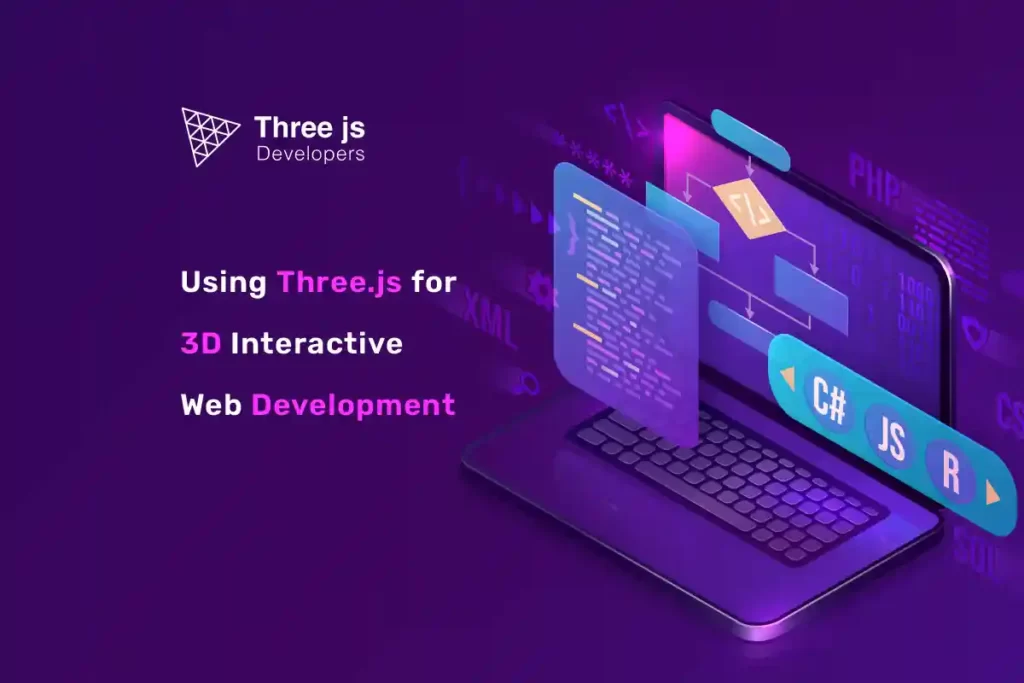If you want to play with 3D graphics on the web, there is no better framework or library than this JavaScript framework called Three.js. It comes with a load set of modern tools and capabilities that easily leverage 3D interactive web experience across devices.
Thanks to Three.js, 3D webs developers enjoy immense flexibility while shaping complex 3D web experiences. This toolkit? It’s like a shortcut to getting those movie-quality lights, dazzling visuals, and all those flashy bits and bobs. Most importantly, they can incorporate crazy interactive things within the same interface.
It’s no shocker that Three.js has become the go-to for 3D game makers, especially when dabbling in the VR and AR scene. And the cherry on top? There’s this super active community around the framework. So, newbies diving in? They’ve got a bunch of pals ready to lend a hand with their creative hurdles.
This blog post will explain how Three.js can shape 3D web experiences across apps of diverse niches.
What are the interactive features Three.js offers?
As we have already said, Three.js is particularly popular for its interactive animation capabilities. Now, let’s quickly look at the key features of Three.js that make such interactions possible.
Device controls:
Three.js can easily use device controls like mouse and touch-pad movements for shaping the 3D visuals. By utilizing these device controls, the users can interact on the screen.
Animations:
Three.js is primarily known for its robust and versatile animation capabilities, allowing you to make the 3D objects lively. Using the framework, you can go into complex layers of the objects.
Physical Reality:
Three.js also has a physics engine to help users interact with more physical effects such as gravitation, speed, collision, etc.
Immersive Interaction Through VR & AR:
Three.js offers a robust library to build VR and AR apps with immersive experiences. You can allow more life-like interactions by using such VR and AR capabilities.
Data Visualization:
If you want to use Three.js for serious data-driven interactions, that is made possible by its robust data visualization features. The framework allows the presentation of data with 3D effects.
Immersive Gaming:
Three.js also helps incorporate all these interactive elements into web-based 3D games. It now stands at par with leading game engines because of this robust interactive feature set.
Want to Build an Interactive 3D web with Three.js? Follow these best practices.
Though Three.js is a well-equipped library for 3D web development, you can only guarantee to reap all its benefits if you know how to unleash Three.js features following best practices. This is why we explain some of the most industry-acclaimed Three.js development practices.
Prior Planning of the 3D Scene:
Don’t go all out programming the Three.js scene at once. Instead, plan carefully and get to the heart of things easily and patiently. List all the interactive 3D objects the project requires and how the visual output will work.
Don’t Forget to Play with Geometry:
3D development cannot do away with geometrical shapes, which cannot be different from projects built with Three.js. It is said that the more polygons you use in a project, the slower the performance will be. So, keep this in mind and reduce polygons as much as possible.
Choose Fast-Loading Materials:
The object materials you choose for the project can also significantly affect the loading time and performance of the app. Usually, unlike highly textured and complex materials, simple materials used for 3D objects do not cause performance and loading troubles.
Use Ideal Renderer:
You have a wide range of renderer choices available in the market, and they differ in terms of features and capabilities to a great extent. This is why you need to pick the perfect one for your purpose.
Leverage Object Pooling:
Pooling of objects is often helpful when it comes to reducing the load on memory, and this is one area you need to consider with utmost priority. So, don’t create many objects for every scene; instead, use object pooling wherever possible.
Use requestAnimationFrame:
Three.js offers an inbuilt method called requestAnimationFrame, widely known for helping with smooth rendering. This method in Three.js helps to sync the animated objects with the browser-based renderer. Most importantly, the same also brings down the instances of renderings that are not required.
Minimize the Number of Lights:
Like objects, even too many lights used in a Three.js app can also impact the speed and performance to a great extent. This is why, to boost the performance of your scene, you need to use as few lights as possible, obviously without sacrificing the look and feel.
Use Level of Detail (LOD):
The more detailed the objects in your scene, the more load your app will need to bear on the memory. To do away with this, use the LOD technique, which is about using lower-detail objects, particularly in scenes where the camera is further away.
Use the WebGLRenderer:
Three.js is primarily built as an abstraction on the earlier framework called WebGL, and hence, it still offers WebGLRenderer as the default rendering tool. By using this, you can pace up the rendering of the scene.
Use Shaders:
Shaders are GPU-run programs in 3D projects to add more effects to scenes. Since GPU is involved here, you can rely on it apart from regular renderers and thus can boost performance to a great extent.
Conclusion
Using this versatile framework, you can build everything with 3D effects. Everything from serious data visualizations to immersive industrial applications to engaging games is possible with Three.js. But when you follow the above-mentioned best practices, you can reap the advantages of this technology better.



